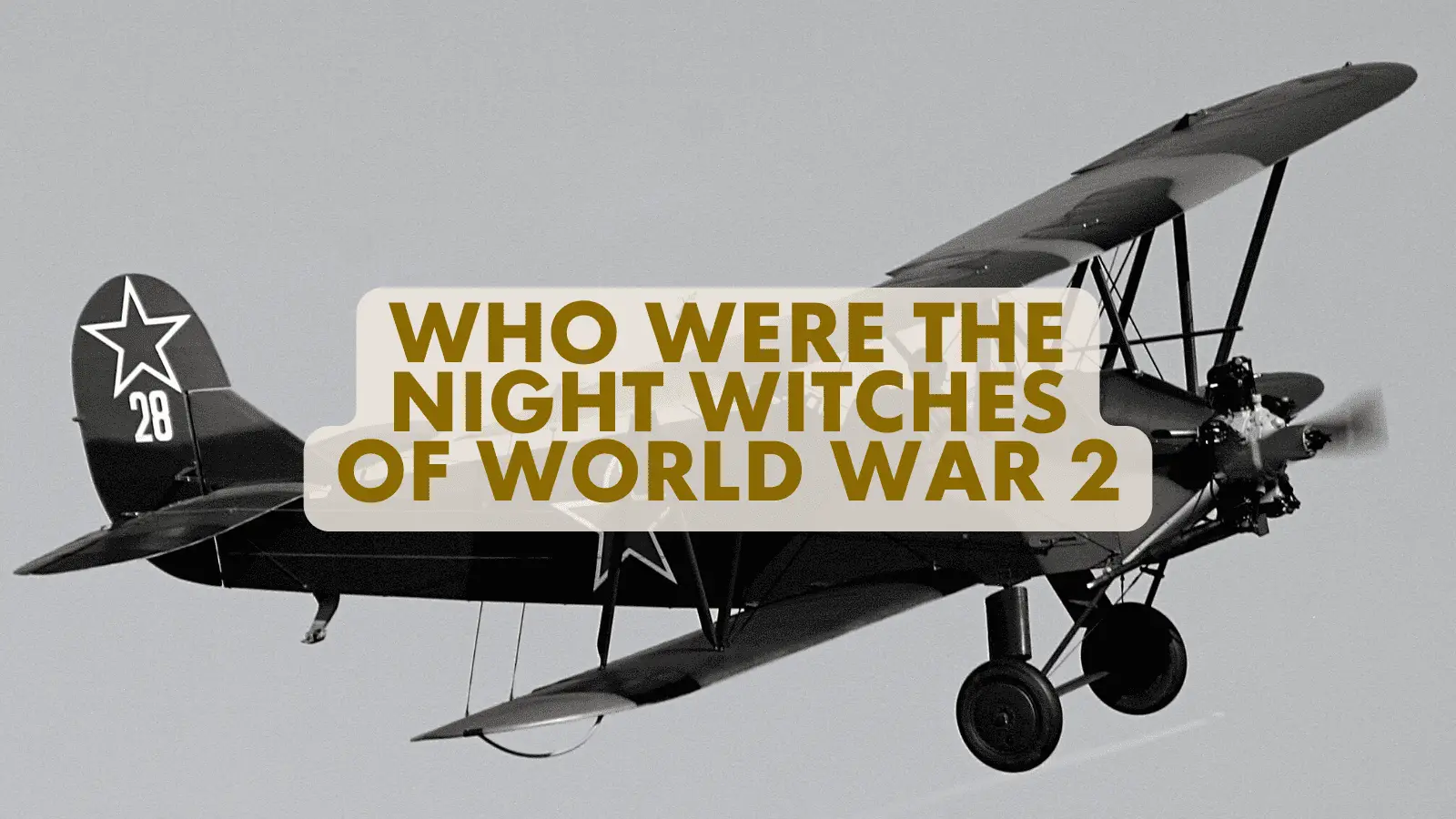Who were the night witches of World War 2
On the Eastern Front in the early 1940s, the German forces were making substantial advances into Soviet Territory. Not much frightened the German soldiers, but one thing certainly did – Die Nachthexen, or the Night Witches. There was little warning before the witches swooped in on their targets. Silence, a roaring whoosh, then explosions all around. There was truly no warning of when the night witch’s terror might begin, or where, as they did not appear on radar. They disrupted German soldiers’ sleep with their nightly attacks, ruining morale and damaging vital targets. The Night Witches were the all-female military aviators of the 588th Night Bomber Regiment of the Soviet Air Forces (later renamed the 46th Guard Night Bomber Aviation Regiment). But, at the start of the Second World War, there were no female aviators, no Night Witches. That would change in 1941.
[/et_pb_text][/et_pb_column][/et_pb_row][et_pb_row _builder_version=”4.14.8″ _module_preset=”default” global_colors_info=”{}”][et_pb_column type=”4_4″ _builder_version=”4.14.8″ _module_preset=”default” global_colors_info=”{}”][et_pb_text _builder_version=”4.14.8″ _module_preset=”default” global_colors_info=”{}”]What units made up the famed Night Witches?
[/et_pb_text][/et_pb_column][/et_pb_row][et_pb_row _builder_version=”4.14.8″ _module_preset=”default” column_structure=”1_5,3_5,1_5″][et_pb_column _builder_version=”4.14.8″ _module_preset=”default” type=”1_5″][/et_pb_column][et_pb_column _builder_version=”4.14.8″ _module_preset=”default” type=”3_5″][et_pb_image src=”http://historywithhenry.com/wp-content/uploads/2022/03/1-3.jpg” _builder_version=”4.14.8″ _module_preset=”default” alt=”Night Witches WW2″ title_text=”1″ hover_enabled=”0″ sticky_enabled=”0″][/et_pb_image][/et_pb_column][et_pb_column _builder_version=”4.14.8″ _module_preset=”default” type=”1_5″][/et_pb_column][/et_pb_row][et_pb_row _builder_version=”4.14.8″ _module_preset=”default” global_colors_info=”{}”][et_pb_column type=”4_4″ _builder_version=”4.14.8″ _module_preset=”default” global_colors_info=”{}”][et_pb_text _builder_version=”4.14.8″ _module_preset=”default” global_colors_info=”{}”]The idea came from Marina Raskova, the 1st woman in the Soviet Union to achieve the diploma in professional air navigation. A woman with a wealth of experience in flying who, like many others, was initially declined to join the Soviet Air Force. Raskova used her personal connection to Soviet leader Joseph Stalin to convince him to allow women to join the air force, insisting they could be of great value. A month after this speech to Stalin, three all-women combat regiments were formed. Raskova would not live to see the end of the war but her influence to start these regiments proved crucial to the allied victory. The 586th, 587th, and 588th Night Bomber Regiments of the Soviet Air Forces were all women, including pilots, navigators, ground crew, and support staff. Specialising in harassing the German soldiers and precision bombing, the regiments would be active from 1942 until the end of the war in 1945, where many were awarded medals for their heroic actions. But it didn’t start off smoothly for the women of the Soviet Air Force.
[/et_pb_text][/et_pb_column][/et_pb_row][et_pb_row _builder_version=”4.14.8″ _module_preset=”default” global_colors_info=”{}”][et_pb_column type=”4_4″ _builder_version=”4.14.8″ _module_preset=”default” global_colors_info=”{}”][et_pb_text _builder_version=”4.14.8″ _module_preset=”default” global_colors_info=”{}”]Problems when the Night Witches were formed
[/et_pb_text][/et_pb_column][/et_pb_row][et_pb_row _builder_version=”4.14.8″ _module_preset=”default” column_structure=”1_5,3_5,1_5″][et_pb_column _builder_version=”4.14.8″ _module_preset=”default” type=”1_5″][/et_pb_column][et_pb_column _builder_version=”4.14.8″ _module_preset=”default” type=”3_5″][et_pb_image src=”http://historywithhenry.com/wp-content/uploads/2022/03/2-3.png” _builder_version=”4.14.8″ _module_preset=”default” alt=”Night Witches WW2″ title_text=”2″ hover_enabled=”0″ sticky_enabled=”0″][/et_pb_image][/et_pb_column][et_pb_column _builder_version=”4.14.8″ _module_preset=”default” type=”1_5″][/et_pb_column][/et_pb_row][et_pb_row _builder_version=”4.14.8″ _module_preset=”default” global_colors_info=”{}”][et_pb_column type=”4_4″ _builder_version=”4.14.8″ _module_preset=”default” global_colors_info=”{}”][et_pb_text _builder_version=”4.14.8″ _module_preset=”default” global_colors_info=”{}”]When the regiments first began training in 1941, they would be looked down upon by their male counterparts, sexually harassed, and be given outdated equipment. But the women did what they could with what they were given, stuffing their oversized male hand-me-down uniforms with duvets. Even the planes they flew were outdated Polikarpov U-2 biplanes from 1927, designed for training and crop dusting and made from plywood and canvas, which didn’t offer much protection from gunfire or the elements. Despite these disadvantages, the women flying excelled at causing chaos, especially the 588th Regiment, who were considered to be the least experienced.
[/et_pb_text][/et_pb_column][/et_pb_row][et_pb_row _builder_version=”4.14.8″ _module_preset=”default” global_colors_info=”{}”][et_pb_column type=”4_4″ _builder_version=”4.14.8″ _module_preset=”default” global_colors_info=”{}”][et_pb_text _builder_version=”4.14.8″ _module_preset=”default” global_colors_info=”{}”]Key Operations
[/et_pb_text][/et_pb_column][/et_pb_row][et_pb_row _builder_version=”4.14.8″ _module_preset=”default” global_colors_info=”{}”][et_pb_column type=”4_4″ _builder_version=”4.14.8″ _module_preset=”default” global_colors_info=”{}”][et_pb_text _builder_version=”4.14.8″ _module_preset=”default” global_colors_info=”{}”]The Night Witches of the 588th Regiment saw their first action on the 12th of June 1942, where they were tasked with bombing bridges and roads on the rivers Mius, Severny Donets, and Don. Their outdated planes turned out to be their most significant advantage in evading chasing German aircraft. The top speed of the Polikarpov U-2 was slower than the speed that the German chasing planes would stall at, making it difficult to track the night witches. However, the aircraft was incapable of carrying more than two explosives because of their lightweight design, which meant that the women would often complete upwards of 8 attacks in one night, dropping two bombs and returning to pick up more. Though they were slow and highly maneuverable, they would be nicknamed “a coffin with wings” by the women flying them as they were quickly shot down by ground forces and left many women with frostbite.
[/et_pb_text][/et_pb_column][/et_pb_row][et_pb_row _builder_version=”4.14.8″ _module_preset=”default” global_colors_info=”{}”][et_pb_column type=”4_4″ _builder_version=”4.14.8″ _module_preset=”default” global_colors_info=”{}”][et_pb_text _builder_version=”4.14.8″ _module_preset=”default” global_colors_info=”{}”]Who was the commander of the Night Witches?
[/et_pb_text][/et_pb_column][/et_pb_row][et_pb_row _builder_version=”4.14.8″ _module_preset=”default” column_structure=”1_5,3_5,1_5″][et_pb_column _builder_version=”4.14.8″ _module_preset=”default” type=”1_5″][/et_pb_column][et_pb_column _builder_version=”4.14.8″ _module_preset=”default” type=”3_5″][et_pb_image src=”http://historywithhenry.com/wp-content/uploads/2022/03/3-3.jpg” _builder_version=”4.14.8″ _module_preset=”default” alt=”Night Witches WW2″ title_text=”3″ hover_enabled=”0″ sticky_enabled=”0″][/et_pb_image][/et_pb_column][et_pb_column _builder_version=”4.14.8″ _module_preset=”default” type=”1_5″][/et_pb_column][/et_pb_row][et_pb_row _builder_version=”4.14.8″ _module_preset=”default” global_colors_info=”{}”][et_pb_column type=”4_4″ _builder_version=”4.14.8″ _module_preset=”default” global_colors_info=”{}”][et_pb_text _builder_version=”4.14.8″ _module_preset=”default” global_colors_info=”{}”]Yevdokiya Davidovna Bershanskaya was the Regimental Commander of the Night Witches and would be the only woman to ever receive the Order of Suvorov, which was given for skillful organisation of the operation and management of her forces. Bershanskaya was positioned as the Commander as she already had 10 years of flying experience before joining the Soviet Air Force. This, with her strong will and ability to put together an excellent unit, meant that she was perfect for the job. In total, 24 Night Witches under Bershanskaya would be awarded Hero of Soviet Union medals for their actions in battle, some self-sacrificing like that of Raskova so other planes in the unit could escape to safety. As well as these women, two would be named Heroes of the Russian Federation and another a Hero of Kazakhstan, the highest possible titles in each country. Navigator Tatyana Sumarokova would join the Air Force despite zero prior experience; by the end of the war, she would drop more than 100 tonnes of bombs in 800 missions and be awarded the Order of the Red Banner and given the title of Hero of the Russian Federation.
[/et_pb_text][/et_pb_column][/et_pb_row][et_pb_row _builder_version=”4.14.8″ _module_preset=”default” global_colors_info=”{}”][et_pb_column type=”4_4″ _builder_version=”4.14.8″ _module_preset=”default” global_colors_info=”{}”][et_pb_text _builder_version=”4.14.8″ _module_preset=”default” global_colors_info=”{}”]Are there any Night Witches still alive?
[/et_pb_text][/et_pb_column][/et_pb_row][et_pb_row _builder_version=”4.14.8″ _module_preset=”default” global_colors_info=”{}”][et_pb_column type=”4_4″ _builder_version=”4.14.8″ _module_preset=”default” global_colors_info=”{}”][et_pb_text _builder_version=”4.14.8″ _module_preset=”default” global_colors_info=”{}”]The last surviving Night Witch was Nadeznda Popova, who passed away on 6th July 2013 in Moscow. Popova joined the Regiment at the age of 19 and would remain in the air force until the end of the war in 1945 when she was 23, completing more than 730 missions with the 588th Regiment in her time with the military. Shot down multiple times in her 4 years with the military, Popova was never severely injured, despite once being shot in the helmet and another bullet coming close enough to pierce the map she was holding. But the women were not just effective for their bombing abilities; the regiments also proved key at dropping supplies to soldiers on the ground. In total, they would drop 155 packages of food and ammunition to Soviet forces, one of which was Popova’s relief mission through enemy fire to trapped Soviet soldiers in Malaya Zemlya, a Soviet outpost on Cape Myskhako. She would be awarded the Hero of the Soviet Union medal for her efforts in February 1945.
[/et_pb_text][/et_pb_column][/et_pb_row][et_pb_row _builder_version=”4.14.8″ _module_preset=”default” global_colors_info=”{}”][et_pb_column type=”4_4″ _builder_version=”4.14.8″ _module_preset=”default” global_colors_info=”{}”][et_pb_text _builder_version=”4.14.8″ _module_preset=”default” global_colors_info=”{}”]What impact did the Night Witches have on WW2?
[/et_pb_text][/et_pb_column][/et_pb_row][et_pb_row _builder_version=”4.14.8″ _module_preset=”default” global_colors_info=”{}”][et_pb_column type=”4_4″ _builder_version=”4.14.8″ _module_preset=”default” global_colors_info=”{}”][et_pb_text _builder_version=”4.14.8″ _module_preset=”default” global_colors_info=”{}”]By the end of the war, the Night Witches would have completed more than 23,000 missions, ranging from simple bombing runs on roads and rivers to key destructions of German buildings and weapons in the Battle of Caucasus. The women would fly in both defensive and offensive missions up and down the front on the Soviet border, where German advances battled fiercely. Throughout the entire Second World War, all three regiments would remain entirely female. Together the 80 crew members of the 588th Regiment would amass more than 28,000 flight hours, more than 3 years worth of constant flight. In their missions, more than 170 armoured cars were destroyed, 170 river crossings collapsed, 20 warehouses wrecked, and 10 searchlights felled.
[/et_pb_text][/et_pb_column][/et_pb_row][/et_pb_section]





